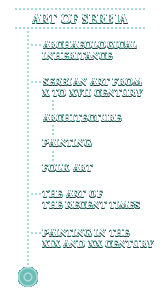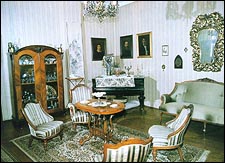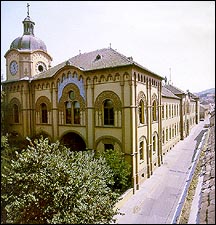




|
The basic changes in the architecture of the 19th century took place after 1830 thanks to the rights derived from the hatiserif (Turkish law) of the same year. The constructors coming from the parts under Austria had a major role in these changes. That is why the buildings of that time are of classicists characteristics : Djumur Kana (Customs), The Synod Church and the house of Cvetko Rajovic (all three of them in Belgrade). The end of the 19th century is marked by introduction of new ideas and more frequent presence of domestic architects : Alexandar Bugarski, Constantin A. Jovanovic, Svetozar Ivackovic and Jovan Ivcic.
Contrary to the Serb architecture and graphics in Austria in which the influence of the foreign artists plays an important role, painting had and still is leaning on its own capacities. In Serbian art of the 18th century the late influence of baroque did not find fertile soil. In the work of Teodor Kracun, of Jakov Orfelin and of Teodor Ilic Cesljar, the best baroque painters in Serbia, one could speak about moderate and orthodox like conception of more formal than basic characteristics of baroque. In the second half of the eighteenth century there is a wood carving renaissance. Good workshops and craftsmen, among which the Novi Sad family Markovic was a leader, founded the development of the applied arts. |
Email: ooc@srbija.sr.gov.yu
 The 18th century is a century of rapid development of the city population. That process developed in the part of Serbian population under the reign of Austria. Thus most of the churches that were renewed by the beginning of the 18th century (Monasteries Krusedol and Velika Remeta) and of those that were built (Bodjani, Jazak I Sremska Kamenica) are marked by medieval poverty with elements of German baroque construction. And in that process the baroque details were most often added to the facade of the three leaf basement with a central cupola or a baroque bell was constructed beside the church. Representative monuments of that kind are The Church Of The Sisatovac Monastery (1758-1773) as well as The Synod Temple in Sremski Karlovci (1758-1762).
The 18th century is a century of rapid development of the city population. That process developed in the part of Serbian population under the reign of Austria. Thus most of the churches that were renewed by the beginning of the 18th century (Monasteries Krusedol and Velika Remeta) and of those that were built (Bodjani, Jazak I Sremska Kamenica) are marked by medieval poverty with elements of German baroque construction. And in that process the baroque details were most often added to the facade of the three leaf basement with a central cupola or a baroque bell was constructed beside the church. Representative monuments of that kind are The Church Of The Sisatovac Monastery (1758-1773) as well as The Synod Temple in Sremski Karlovci (1758-1762).
 The rise of the architecture in Serbia started by the end of the fifties of this century. The new materials: iron , steal iron, concrete and glass with new ideas have marked the construction solutions. Today's architecture life in Serbia in theory and in practice is characterized by lot of varieties marked by postmodern ideas of art practice.
The rise of the architecture in Serbia started by the end of the fifties of this century. The new materials: iron , steal iron, concrete and glass with new ideas have marked the construction solutions. Today's architecture life in Serbia in theory and in practice is characterized by lot of varieties marked by postmodern ideas of art practice.